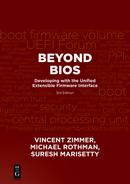Contents
EFI Becomes UEFI—The UEFI Forum
Embedded Systems: The New Challenge
How the Boot Process Differs between a Normal Boot and an Optimized/Embedded Boot
Chapter 2 – Basic UEFI Architecture
Objects Managed by UEFI-based Firmware
Events and Task Priority Levels
Why a Driver Model Prior to OS Booting?
Bus Driver that Creates All of Its Child Handles on the First Call to Start()
Bus Driver that Is Able to Create All or One of Its Child Handles on Each Call to Start():
Chapter 4 – Protocols You Should Know
Device Path and Image Information of the OS Loader
Accessing Files in the Device Path of the OS Loader
Getting the Current System Configuration
Getting the Current Memory Map
Isn’t There Only One Kind of Memory?
How Are Runtime Services Exposed?
Chapter 6 – UEFI Console Services
Chapter 7 – Different Types of Platforms
Chapter 8 – DXE Basics: Core, Dispatching, and Drivers
Global Coherency Domain Services
Boot Device Selection (BDS) Phase
Chapter 9 – Some Common UEFI and PI Functions
Architectural Protocol Examples
Real Time Clock Architectural Protocol
Boot Device Selection Architectural Protocol
Variable Architectural Protocol
Watchdog Timer Architectural Protocol
PCI Host Bridge Resource Allocation Protocol
Using the Configuration Infrastructure
Chapter 10 – Platform Security and Trust
Trusted Platform Module (TPM) and Measured Boot
What Is a Trusted Building Block (TBB)?
What Is the Point of Measurements?
UEFI User Identification (UID)
Hardware Evolution: SRTM-to-DRTM
Chapter 11 – Boot Device Selection
Default Behavior for Boot Option Variables
Intel® Itanium® Processor Reset
Basic G0-to-S0 and S0 Variation Boot Paths
Special Intel Itanium® Architecture Boot Paths
Intel Itanium® Architecture Access to the Boot Firmware Volume
Chapter 13 – Pre-EFI Initialization (PEI)
Pre-EFI Initialization Modules (PEIMs)
PEIM-to-PEIM Interfaces (PPIs)
Intel® Itanium® Processor MP Considerations
The “Terse Executable” and Cache-as-RAM
Chapter 14 – Putting It All Together–Firmware Emulation
Chapter 15 – Reducing Platform Boot Times
What Are the Supported OS Targets?
Do We Have to Support Legacy Operating Systems?
Do We Have to Support Legacy Option ROMs?
Are We Required to Display an OEM Splash Screen?
What Type of Boot Media Is Supported?
What Is the BIOS Recovery/Update Strategy?
Is There a Need for Pre-OS User Interaction?
Adjusting the BIOS to Avoid Unnecessary Drivers
Steps Taken in a Normal and Optimized Boot
Organizing the Flash Effectively
Chapter 16 – Embedded Boot Solution
Distributed Management Task Force (DMTF)
UEFI Error Format Standardization
Windows Hardware Error Architecture and the Role of UEFI
Technology Intercepts: UEFI, IPMI, Intel® AMT, WS-MAN
Intelligent Platform Management Interface (IPMI)
Intel® Active Management Technology (Intel AMT)
Web Services Management Protocol (WS-MAN)
